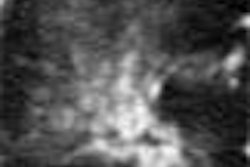Advances in sophisticated noninvasive screening capabilities and accelerating consumer healthcare expectations converge daily at the contemporary preventive imaging centers that dot the 21st-century landscape. In large part, this has been driven by widespread media coverage of screening exams and appealing advertisements touting the benefits of a "fantastic voyage" through "le corps intérieur."
Growing dissatisfaction with routine office visits and the realization that significant medical problems can escape the detection of even the most astute primary care physician have also fueled interest in "radiology on demand." Body scans, heart scans, lung scans, and virtual colonoscopy are not frequently mentioned by interventionally oriented physicians, nor are these scans widely covered by managed care plans. These factors have contributed to the entrepreneurial nature of many facilities offering the procedures, which appeal to the legitimate (and occasionally unrealistic) concerns of the proactive "worried well" consumer.
One need only read the Wall Street Journal, Time, Newsweek, or the local newspaper to learn how imaging's most outspoken practitioners and radiology societies feel about the practice of radiology screening (other than mammography). By and large, it is negative.
Medical paternalism and misconception?
In some part, the resentment towards preventive imaging is a reflection of medical paternalism, ignorance, and misconception. The concept that a proactive consumer can flash a credit card and purchase a cardiac or lung test without medical referral does not sit well with everyone, especially with doctors whose own reimbursement depends upon preapproval from insurance.
Many doctors do not understand how to interpret or act upon the findings of a screening exam, particularly of a coronary artery scan. In fact, the results of heart scans routinely contradict the impression patients get from an office visit, since millions of Americans with unremarkable cholesterol levels and normal treadmill tests will have moderate or alarmingly high coronary calcium scores.
Armed with such information, a patient may challenge the diagnostic acumen and preventive orientation of his or her physician, which can lead to strong resentment towards the imaging facility that prompted the confrontation. In many cities, the reputations of preventive imaging programs clearly suffer from a lack of widespread community physician support, and from exaggerated concerns about radiation dosage, patient anxiety, and the potential for costly further testing.
Legitimate concerns about responsible practice
Clearly, the negative perception of radiology screening is also due, in large part, to examples of marginal imaging practices, exaggerated claims of efficacy, and inadequate attention to patient follow-up in some cities. For example, there are now itinerant mobile CT scanning vans that travel to out-of-state church parking lots collecting new patients and images to send back to reading radiologists back home. This is a practice that minimizes the opportunity for the patient to interact with his/her local physician or interpreting radiologist. One wonders what occurs when the patient has suspected symptomatic coronary disease and has to wait a few weeks for a calcium score.
A better practice might be to involve the patient’s own physician at the outset and re-establish a clinical context. In some newspapers and radio ads, the consumer is informed that a body scan is the best defense against cancer and a host of other illnesses. The procedures are attractive enough. Hyperbole simply cheapens the value of all of our imaging programs.
Screening the screening patients
Undoubtedly, multislice CT and electron beam tomography (EBT) scanners with advanced 3-D workstations have extraordinary capabilities. We can indeed screen large groups of people expeditiously and at low risk while creating dramatic and detailed images of various organs. This capability often attracts consumers outside a physician relationship, and should oblige the imaging facility to undertake a higher level of responsibility.
The competitive imaging environment is filled with potential practice pitfalls and abuses. Careful examination of policies related to appropriate patient selection by a highly educated and ethical staff is critical. There should be well-conceived entry and denial criteria for each procedure.
Certainly, the value of the "total body scan" is easy to exaggerate, while the barrier to entry should be considerably higher than a valid credit card. Indeed, older individuals with established heart disease are tempted to undergo a noninvasive heart scan to "check on things," while young affluent adults are commonly desirous of a total body scan.
The patient with a history of abdominal malignancy wishing to check on possible recurrence should be informed that a non-contrast CT scan of the abdomen is inadequate. Shouldn’t the front office of every facility be trained to recognize and dissuade inappropriate candidates for imaging procedures?
Radiologists running busy coronary imaging practices might review the published indications for EBT calcium scoring developed by the Society of Atherosclerosis Imaging. Their staff should understand the precise indications for virtual colonoscopy, and understand when to dissuade inappropriate candidates. You and your colleagues need to be educated well enough to clarify the predictable misconceptions in the community so as to articulate the true roles and specific limitations of the available technologies.
How good are your reports, doctor?
The manner in which a facility handles patient results may reveal the quality of its service and its reputation among community physicians. Diagnostic radiology practices which have recently added "preventive imaging" capabilities to the menu may be practicing with a significant education gap when it comes to recommendations for radiologic findings.
In addition, significant and cooperative alliances with knowledgeable internists and other specialists may not have been developed. In such instances, the radiology screening practice may be regarded as financially opportunistic, rather than integrated within community standards and offering a valuable service.
Illogical or inconsistent recommendations by radiology staff virtually guarantee that the public and primary care physician will harbor major misunderstandings about the procedures offered. They may also be the genesis of the prevalent negativity found in the media. Anecdotes about expensive and risky testing subsequent to the discovery of a benign lung nodule or modest coronary plaque seems to be included in every lay article on body scanning.
As the reputation of preventive imaging has continued to decline, it is a good time to ask your staff a few questions. Are your reports consistent with current recommendations emanating from specialty conferences? Are your readers aware of the published guidelines for handling common radiologic findings on a chest screening exam, CT colonoscopy, or an elevated coronary calcium score on a heart scan? When is a formal cardiology consultation necessary for provocative stress testing or angiography?
There are now several hundred peer-reviewed articles on coronary calcification imaging, guidelines for therapy, and even a multimedia physician coronary imaging CD-ROM guide available to physicians. In addition, there are excellent lung screening conferences and international symposia and workshops on CT colonography or virtual colonoscopy.
I am a strong proponent of preserving self-referral for the knowledgeable proactive citizen who cares about prevention. Requiring a physician referral for screening puts each citizen at the mercy of the preventive orientation of his/her individual doctor at a time when our reward system is skewed toward intervention or office-based testing.
Even if the patient arrives independent of a physician’s advice, imaging centers must make a concerted effort to ensure that radiologic results are converted to opportunities for physician counseling, therapy, and risk-reduction strategies. Often this involves a personal call to a physician to ensure that the self-referred individual with an abnormal result is brought back into the physician-patient environment.
Introducing a new imaging society
The newly created Society for Responsible Preventive Imaging (SRPI) was formed to help preserve the reputation and value of legitimate preventive radiologic services and to guide facilities to improve practices and policies. SRPI hopes to help radiologic professionals by offering guidelines for best practices and to help referring physicians understand how to better integrate radiologic findings into clinical decision-making.
SRPI is also concerned with issues such as radiation safety and appropriateness of certain examinations. For example, high-radiation procedures such as retrospectively gated multislice CT angiography may be warranted for important diagnostic situations, but are clearly ill advised for screening as they expose the individual to many times the radiation dose of a prospectively triggered electron-beam angiogram. SRPI plans to develop protocols to help centers use the lowest possible radiation for each procedure, and establish guidelines governing the frequency of screening tests.
Important new published applications of imaging and findings discussed at contemporary conferences will be disseminated by SRPI. Press releases illuminating effective and important uses of radiology screening modalities will be issued in order to promote wider acceptance of high-quality imaging practice.
Finally, industry spokespersons involved in responsible preventive imaging will be available to directly address misconceptions among the media, physicians, and consumers.
How radiologists promote themselves, the knowledge level and ethical standards of our personnel, and the responsibility we take for our patients’ preventive concerns will ultimately determine the viability of preventive imaging programs nationwide. Isn’t it time we consider more carefully whether our imaging facilities care enough about the reputation of this field?
By Dr. James EhrlichAuntMinnie.com contributing writer
November 24, 2003
Dr. Ehrlich is medical director of Colorado Heart and Body Imaging and is medical co-director of HeartScan of Indiana and HeartCheck Washington, DC. He is president of the Society for Responsible Preventive Imaging (SRPI) and a co-founder of the Society of Atherosclerosis Imaging. He can be reached at 303-433-1511, or at [email protected].
Related Reading
Mayo 'whole-body' screening keeps an eye on the brand, October 3, 2003
Guidelines sought for self-referred imaging amid ethical concerns, August 14, 2003
Reimbursement gains, competition prime CAD market, July 15, 2003
Whole-body CT picks up renal cell carcinoma in asymptomatic patients, May 28, 2003
Whole-body CT: Greater than the sum of its parts?, May 20, 2003
Legal issues shadow CT screening, February 27, 2003
The opinions expressed in guest editorials are those of the author, and do not necessarily reflect the views of AuntMinnie.com.
Copyright © 2003 AuntMinnie.com




















